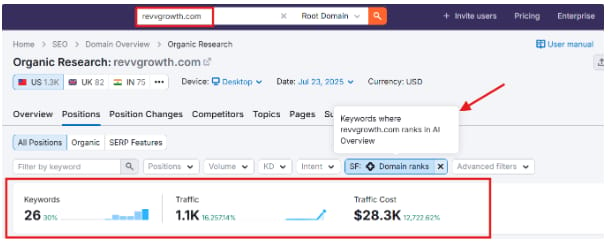- Call To Action
- Posts
- Stop Chasing Google Rankings
Stop Chasing Google Rankings
...Here’s What Really Drives Traffic!
$0 to $28.3K in traffic cost!
All from AI Overview wins in 6 months!
Revv Growth started with zero AI visibility, zero traffic, and no ranking keywords.
From this:

To this:

Now we’re featured across Google’s AI Overviews for high-intent SaaS terms.
All this purely from strategic SEO and a carefully designed AI Optimization (AIO) strategy.

Here’s the reality:
SEO in 2025 isn’t just about rankings.
It’s about visibility in AI-generated results, the trusted first-stop for users seeking quick, reliable answers.
And if you are consistently appearing in AI Overviews, that's game-changing.
Here’s exactly how we did it, and how you can too:
It’s not as hard as you might think to start showing up in AI Overviews — it all begins with smart, targeted SEO.
Let’s get into the process!
1. Start Where the Opportunity Already Exists
Forget spraying and praying. Instead, find keywords you're already ranking for, and filter for informational queries (think: “how to,” “what is,” “best tools for…”).
Then see if AI Overviews pop up.
These are your goldmines: queries where Google already trusts AI content.

That’s your signal: double-down here.
Pro tip: Use SEMrush or Ahrefs to quickly identify these opportunities and prioritize queries already triggering AI Overviews.
2. Build SEO That AI Actually Understands
It's not just about keywords anymore. It’s structure, clarity, and intent.
We mapped pillar keywords (high-intent terms closely aligned to our product) to well-defined category pages.
We didn’t stop there:
Built clear URL structures
Created author pages to boost E-E-A-T
Result? Google and AI knew exactly where to look and why our content mattered.
Key takeaway: Create clean, scalable site architecture, and ensure every URL clearly communicates your primary keyword.
3. Keyword Briefs That Guide (Not Guess)
Every piece of content we created started with a detailed keyword brief.
Not just keywords, but insights:
SERP analysis to understand what's ranking (and why)
AI Overviews analysis (knowing exactly what AI chooses to surface)
Internal linking strategy (to build authority)
Natural product placements
We gave our writers a roadmap, not a guessing game.
Actionable tip: Always map user intent (informational, comparative, transactional) clearly in your briefs. This ensures your content matches exactly what users and AI are looking for.
4. Technical SEO: Clearing the Path
No point creating amazing content if Google (or AI) can't find it.
We did a full audit and addressed issues in order of impact:
High-priority fixes: indexing, security, core web vitals
Medium-priority fixes: broken links, image optimization
Low-priority fixes: pagination, international SEO
We didn't just fix these for Google. We fixed them to help AI better crawl, understand, and trust our site.
Pro tip: Regularly audit your website using tools like Screaming Frog and Google's Core Web Vitals reports to proactively address technical SEO issues.
High-quality backlinks aren’t just SEO vanity metrics; they’re trust signals for AI.
We strategically placed links through:
Guest posts
Niche edits
Community platforms like Reddit and Quora
Every single backlink passed our rigorous quality test:
High domain authority
Relevant anchor texts
Natural placement within authoritative content
These backlinks turned our pages from good reads into must-cite resources for AI engines.
Key takeaway: Always vet backlinks for relevance, authority, and natural context to ensure they positively influence your AI visibility.
Why Does All This Matter?
Because SEO in 2025 is about winning trust and visibility in AI-generated results.
A place where user interactions increasingly happen first.
So, we stopped chasing rankings. Instead, we focused on strategic SEO and AIO practices.
The result? Significant, sustainable visibility.

So, next time you're working on SEO, don't just ask:
“How do I rank?”
Instead, ask:
“How do I create SEO and AI Optimization that Google's AI engines can't ignore?”
Because when your SEO and AIO strategy are clear, targeted, and reliable, AI remembers you, and so do your users.
Untill next time,
Karthick Raajha.